Speech Economic Trends and Policies
Once again it is a pleasure to have this opportunity to speak to members of the ABE. I believe – I hope correctly – that business economists share our interest in seeking out practical policy responses to our problems.
Today, I would like to offer some comments on current economic trends and their implications for policy. They will have a familiar ring to many of you.
The Past Year
Looking back for a moment, by most measures 1994 was a very good year for the Australian economy:
- despite the drought, GDP appears to have grown by 5 to 6 per cent;
- employment increased by over 280,000 or 3½ per cent;
- unemployment declined by 130,000, including a fall of more than 60,000 in the number of long-term unemployed;
- the unemployment rate fell by 1¾ percentage points to a touch under 9 per cent;
- business investment at last took off, increasing by over 20 per cent in real terms;
- business profits increased by around 10 per cent, and the profit share of national income continued to hover around its historical levels; and
- underlying inflation remained around 2 per cent.
The combination of rapid growth and low inflation was most welcome, leading as it did to a sharp reduction in unemployment. It was only possible, however, because we had considerable spare capacity to begin with. As that capacity is taken up, it is natural – and necessary – for the growth rate to slow. That is now happening.
Yet, despite these trends, there appear to be popular concerns that all is not well – that we are in danger of lapsing into our old boom/bust ways, when a spurt in growth caused both inflation and the current account to career out of control. These are legitimate concerns for policy makers at this time but I believe – more than some others perhaps – they will be managed satisfactorily.
That management has begun already, with interest rates being raised on three occasions late last year. Those largely pre-emptive rises have helped to settle the exuberance of consumers and home buyers which, six months ago, was threatening to bubble over.
That, of course, was the purpose of the interest rate rises. To make further inroads into unemployment, we need sustained economic growth, not an inflationary ‘dash’. Since the recovery commenced in mid 1991, real GDP has grown by close to 15 per cent; employment is up by around 500,000 (6½ per cent) since its low point in mid 1993. This recovery would not last, however, if total spending were to continue to grow at anything like the 8 per cent recorded in the year to the September quarter: that would lead inevitably to major inflation and current account worries, followed by higher interest rates and unemployment.
Sentiment generally is now less exuberant and – assuming it stays that way – this should help to slow the growth in spending during 1995. So far, the most visible slowing has occurred in the housing sector, and this probably owes more to the maturity of the housing cycle than it does to the relatively modest increase in mortgage rates since last August (less than two percentage points for most mortgage borrowers). For more than two years now, dwelling commencements have been running well ahead of underlying demand, presaging a fairly pronounced correction which still has some way to go.
How quickly the pace of growth slows will have important implications for inflation down the track and, therefore, for monetary policy. Growth does appear to be slowing but – with the notable exception of housing – most sectors are continuing to grow quite strongly, at least to this time.
How much of a slowdown should we be looking for? We can only make informed guesses about these things, but the notion of the long-term potential (or underlying) growth rate provides a couple of clues. This is the highest rate at which the economy can grow without running into inflation and current account constraints.
No-one knows exactly what Australia's long-run potential growth rate is. Some commentators put it around 3 per cent. This seems too pessimistic to me, particularly given signs that productivity is on the rise. After stagnating for several years, investment is now growing again and adding to the nation's capital stock. Anecdotal and other information also point to better productivity performances; in the 1980s, output per hour worked grew at an annual rate of just over 1 per cent but in the past five years it has risen by around 2 per cent a year (see Graph 1). Perhaps it is too early to conclude that this is a permanent improvement, but the structural changes of the past decade must have raised efficiency in many sectors of the economy.
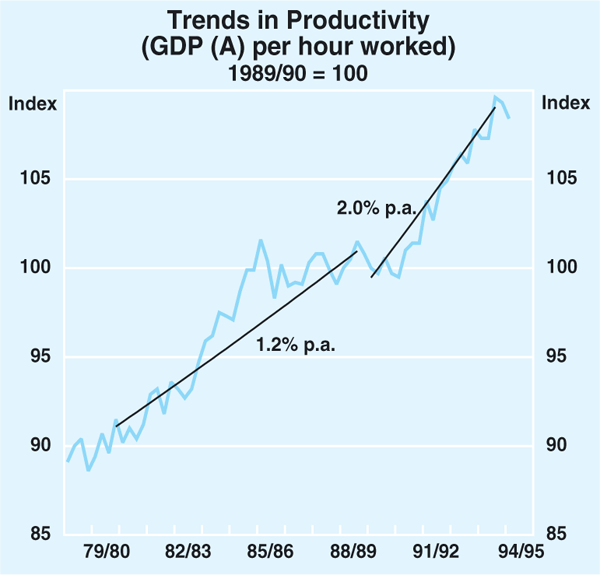
Traditionally, potential growth rates have been viewed as a function of two main components – namely, productivity growth and workforce growth. Over coming years, Australia's workforce is projected to grow by nearly 2 per cent per annum. Predicting labour productivity growth is more difficult, as I have just noted, but with the right focus we should be able to maintain a rate around 2 per cent per annum. On these assumptions, a long-term potential growth rate of around 4 per cent would not seem an unreasonable aspiration for Australia.
You should not infer from these remarks that the Reserve Bank has a ‘growth target’. We do not. Apart from the hypothetical nature of such targets, we recognise, more than most I suspect, that policy cannot be calibrated to achieve and hold any predetermined growth rate.
Instead, what we have is a view about how fast the economy can grow over time without being blown off course by inflation or other pressures. It cannot be a fixed view. If, because of surplus capacity or better long-term productivity performances, a faster growth rate was consistent with maintaining low inflation, we would be more than happy to accommodate that growth. Similarly, if pressures on resources were such that maintaining low inflation required slower growth, then monetary policy has to contribute to that outcome. If, over the medium term, the prospects for growth consistent with low inflation were judged to be inadequate in terms of employment or other objectives, then the focus should be on structural and competition policies aimed at boosting productivity and exerting more discipline on price and wage setters, not on trying to run the economy faster than its inherent capacity.
For present purposes, however, the key point is that if the sustainable growth rate is not 3 per cent, it is not 5 or 6 per cent either. Some slowing from recent growth rates is, therefore, needed. This is occurring but it is not clear, at this time, by how much.
As you know, the Reserve Bank has a major responsibility to keep inflation low. But we must also take account of the impact of our actions on output and employment over the policy time horizon. So we spend a lot of time monitoring the various indicators, weighing up the risks for inflation and growth of policy miscalculations, and coming to what are often on-balance judgments. Currently, views about such things as the outlook for the world economy, the duration of the drought, and the shape of the forthcoming budget must also be factored into policy deliberations. There is nothing new about that process, which is ongoing.
What I would like to emphasise is that should additional data and/or particular developments lead the Bank to a judgment that more (or less) needs to be done on monetary policy, we would follow through on that judgment, irrespective of any overlapping election or budget timetable. This should be more widely appreciated than it appears to be at present. I will say a little more about fiscal policy later, but it follows from what I have just said that while a ‘good’ budget could have implications for monetary policy, it would not necessarily obviate the need for further interest rate action.
Some of these issues – and the challenges they pose for business decision makers as well as for policy makers – will become clearer as we look more closely at the pressures building on inflation and the current account.
Inflationary Pressures
The Reserve Bank's objective is to hold underlying inflation to an average of 2 to 3 per cent over a run of years. This would, in our view, lead to better investment and saving decisions than would occur in an environment of higher inflation.
The 2 to 3 per cent objective was never a narrow band in which we believed inflation must, or necessarily can, be maintained at all times and in all circumstances. That would be too narrow and too constraining a target, given the cyclical and other influences on inflation. Rather, the ‘2 to 3 per cent’ specified an inflation rate we would aim for over the medium term: success would be reflected in an average inflation rate of ‘2 point something’.
An alternative objective which has been suggested for Australia is that we maintain an inflation rate comparable with the average of our major trading partners. This formulation provides a useful reminder of our growing exposure to global markets and the importance of international competitiveness. On the other hand, it downplays domestic considerations. We pursue price stability because our economy will operate better with low inflation, and the average of our major trading partners may not always provide the ‘best practice’ standard. If some of our trading partners happen to run inflation rates that are clearly too high (such as China's 20 per cent plus rate), that does not mean Australia also should run high inflation rates; our low-inflation objective should not be hostage to policy makers in other countries.
The Bank's objective is expressed in terms of underlying inflation, which is less volatile than the inflation rate measured by the overall Consumer Price Index (CPI). The latter has averaged less than 2 per cent per annum over the past three and a half years, but increased by 2½ per cent over the year to the December quarter. We expect this measure to jump sharply when the figure for the year to the March quarter is released in a few weeks time, and to hover around 4 to 5 per cent during 1995. This jump will largely reflect the flow-through of the rises in official interest rates which occurred last year; to give an indication of the magnitudes involved, a one percentage point increase in mortgage and personal loan rates is estimated to boost the CPI directly by between 0.6 and 0.8 of a percentage point.
We are, then, about to observe a graphic demonstration of how the usual CPI measure of inflation can depart from – and be an inappropriate guide to – the ‘underlying’ rate. For macro-economic policy purposes, what matters is the underlying rate, that is, the rate of increase in prices which reflects the balance between supply and demand pressures in the economy, after the effects of any policy measures designed to change that balance have been excluded.
That is why we have focussed on the underlying rate as (now) published by the Statistician (and based on longstanding Treasury methodology). It has been our focus during the period when the underlying rate was above the overall CPI rate; it will, of course, continue to be our focus during the year ahead when it is expected to be somewhat below the overall rate. Whether others are similarly focussed over this period will be an interesting test of the maturity of our economic commentators.
Underlying inflation was running at about 2 per cent in the year to the December quarter. We expect this to rise over the quarters ahead, and to exceed 3 per cent during the course of 1995. Several factors lie behind this forecast, including the absorption of spare capacity, an upward drift in wage rises, and increases in some commodity and materials prices. Were it to persist, the recent decline in the exchange rate would be another contributing factor.
The prospect of underlying inflation exceeding 3 per cent is not, in itself, a cause for alarm. The natural dynamics of inflation over the course of the business cycle can be expected to generate some pressures on the upswing. It does not represent any weakening of our resolve to maintain low inflation. Nor does it mean that inflation is going off-track over the medium term.
It would be a different story if underlying inflation above 3 per cent was set to become entrenched. But that is not the situation, and it is the aim of policy to avoid that situation. To that end, interest rates were raised a total of 2.75 percentage points last year while underlying inflation was still at 2 per cent. Monetary policy remains committed to the 2 to 3 per cent objective and, if necessary, will be adjusted to deal with departures from that objective.
Because labour costs tend to dominate total production costs, the most critical determinant of the future path of underlying inflation will be the size of wage and salary increases. Over the past year, the growth in ordinary-time earnings has quickened a little, to around 4 to 5 per cent (see Graph 2). This rate of increase, together with current rates of productivity growth and profit margins, is broadly consistent with underlying inflation of 2 to 3 per cent. That situation, however, is quite tight; it has no room for further slippage, or for any slowing from current rates of productivity growth.
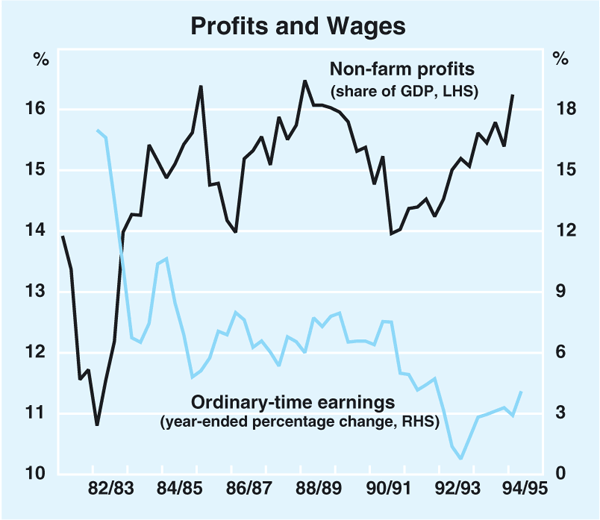
I think some commentators assume too readily that there will be major slippage on wages. The past couple of decades have demonstrated clearly that wage restraint delivers strong jobs growth, and vice versa: that lesson has not gone unheeded. Moreover, attitudes and institutional arrangements are very different today. Having to compete in global markets and to contend with tariff reductions and other structural changes helps to concentrate many minds on the importance of wage restraint. And, despite ongoing wrangles over some aspects, the enterprise bargaining arrangements do appear to be delivering better wage outcomes than the previous centralised system.
Monetary policy – in conjunction with these other policies – also plays a role in shaping an environment conducive to continued price and wage restraint. More people now understand that low inflation comes at too high a cost to be given up at the first whiff of trouble.
To make much the same point in different words, it would be a terrible indictment of everyone involved – policy makers, employees and employers – if serious wage pressures were to break out while unemployment remained around 9 per cent. That would imply that the natural rate of unemployment (the Non- Accelerating Inflation Rate of Unemployment or NAIRU) was higher than 9 per cent! In the United States, where the economy has been growing strongly for several years and the unemployment rate has slipped below 5½ per cent, wage increases have remained around 3 per cent, at least to this time. Comparisons with other countries are seldom straightforward, and different approaches to social safety nets complicate comparisons of our natural rate of unemployment with that in the United States. But the basic point is clear: Australia needs to be able to reduce its unemployment well below current rates without triggering higher inflation.
One argument which has been used recently to justify higher wage claims is that workers should be compensated for increases in mortgage interest rates (and in taxes for that matter). I can well understand the desire of employees to offset the effects of higher mortgage interest rates on their disposable incomes. But that does not make the argument correct: its logic is that interest rates (and taxes) should not be raised because such increases would cause a wages surge and higher inflation. Accepting that logic would lead either to policy gridlock, or to the sort of showdown between policy and labour markets which would leave everyone a loser.
If higher interest rates were to lead to larger wage outcomes, inflationary pressures could be expected to intensify, in the short run. But higher labour costs would increase business costs and squeeze profits. That would be bad for investment and jobs. If employers passed on the higher wage costs, prices would move higher, necessitating further interest rate rises – again with adverse effects on employment.
The simple fact is that when spending (especially private and public consumption spending) is growing at too fast a pace – as it has been – then that spending needs to be curbed through policy tightenings of one kind or another. Seeking to protect incomes and spending from the effects of such measures will only increase the pressure for even more policy tightening, with even higher costs in terms of lost jobs. This should be remembered as the effects of past interest rate rises flow through the Consumer Price Index over the next couple of quarters.
I should explain, as an important footnote to this discussion on wages, that I talk of ‘wage’ restraint as a shorthand for restraint on wages and salaries across the board, including the salaries of managers and executives. The latter appear to have been rising somewhat faster than wages. Whatever the realities of life in an international market for executives, another reality of life is that most ordinary people notice the example set by their bosses. If executives pay themselves increases that are out of line with the increases paid to their employees, they can hardly complain if this is noticed and provokes higher wage claims.
Current Account Pressures
The other major storm cloud to be negotiated is the rising current account deficit. You will recall the Treasurer indicated at the end of January that the current account deficit in 1994/95 was likely to reach $26 billion (or 5¾ per cent of GDP), compared with the budget time forecast of $18 billion (4 per cent).
Several factors are responsible for this increase of $8 billion. The effects of the drought on rural exports are estimated to have contributed about $1.4 billion. Exports of cereals have been the hardest hit, with the wheat crop only half that of last year. With a return to more normal seasonal conditions, rural exports should rebound solidly in 1995/96.
The much faster-than-forecast growth in domestic spending appears to have absorbed some manufactured goods that might otherwise have found their way to export markets. In the second half of 1994, growth in exports of elaborately transformed manufactured goods slowed sharply, after a number of years of strong growth. To the extent that this apparent diversion to domestic markets reflects the recent strength of domestic demand, it should be reversed as the pace of growth slows.
The main cyclical influence on the current account deficit, however, has been on the imports side. Here, the faster growth in domestic spending is estimated to have contributed about $5 billion of the $8 billion increase. Over the second half of 1994, imports of capital goods were 37 per cent higher than in the corresponding period a year earlier; imports of intermediate and consumption goods both rose by about 15 per cent over the same period.
The surge in investment spending is to be welcomed, and will expand our capacity to boost future output and exports. In the absence of a pick-up in domestic saving, however, this investment surge translates into an increase in the current account deficit.
Finally, higher world interest rates, leading to higher net debt service payments, have also contributed to the higher current account deficit, adding about $1½ billion to the budget time forecast.
In summary, the increase in the forecast 1994/95 current account deficit can be explained in terms of the strength of the cyclical upswing, and fluctuations in seasonal conditions and world interest rates. Behind those explanations, however, lies a more fundamental causation, namely the persistent imbalance between saving and investment: as a nation, we spend far more than we earn. If we were to adjust the present estimates for the effects of weather and world interest rates (over which we have no control), and to assume more normal investment and growth rates, we would still be left with a current account deficit equivalent to around 4½ per cent of GDP.
This is the structural dimension of our current account problem. It is perhaps best illustrated by the fact that net service payments on foreign liabilities have risen to the point where they alone now represent about 4 per cent of GDP (see Graph 3).
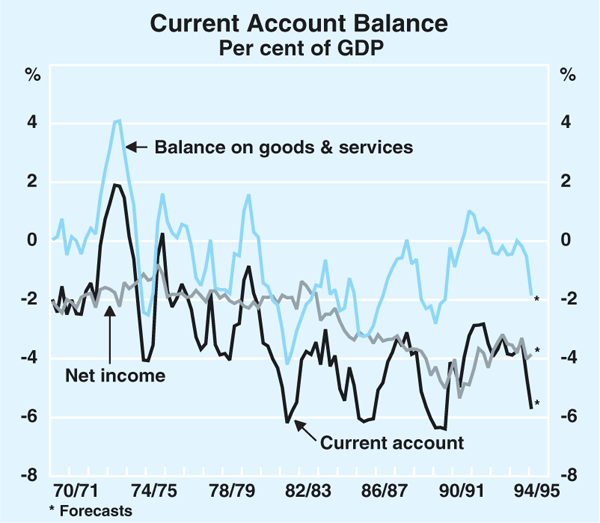
I have said before that, while there can be no precision in these matters, we could all feel a lot more comfortable if the average current account deficit over the business cycle was somewhat lower. A deficit which averaged around 3 per cent, for example, would stabilise the ratio of net foreign liabilities to GDP around current levels.
So long as we remain so dependent on foreign savings, for which we must compete in international capital markets, we will remain vulnerable to adverse swings in market sentiment. The most obvious vulnerability is our exposure to a sharply falling exchange rate. We know from past experience that the markets can sometimes turn sharply against Australia and the $A, not always for well-based reasons. Downward pressure on the exchange rate, if it were to persist, would add to inflationary pressures, and force the authorities into tough policy measures. The best counter here, of course, is to pursue fundamentally sound policies as a matter of course.
The necessary thrust of those policies seems straightforward enough. The cyclical dimension of the current account problem will be assisted by measures to remove excess demand pressures. In addition, we need, over time, to run a significant surplus on the balance of trade in goods and services – to spend less than we produce – which means increasing our national savings (to address the structural dimension).
The budget has a role to play on both fronts. First, by restraining private and/or public spending, it can help to slow economic growth to a more sustainable rate, thereby easing pressures on both inflation and the current account. The extent of the budget deficit reduction, and the manner in which it is achieved, are obviously important here. I would add only that, given the stage of the economic cycle, the next budget should, on macro-economic grounds, be moving much closer towards balance.
Viewed in these terms, a ‘good’ budget could be seen as easing the pressure for possible further monetary policy tightenings. That is true. But even a ‘good’ budget would not necessarily rule out further interest rate adjustments. For one thing, we could not be sure that such a budget would cause the economy to slow sufficiently, particularly given the favourable effects it could have on confidence generally. The implications for monetary policy of a ‘bad’ budget are, however, rather clearer.
As for reversing the decline in national saving (and reducing our dependence on foreign saving), the broad options are well understood. Greater provision for personal retirement is probably the main means of raising, over time, the level of private saving. It is in the area of public-sector saving, however, that the largest trend decline has occurred (see Graph 4) and where, in the short term, the greatest scope exists to boost national saving – through the reduction and elimination of budget deficits.
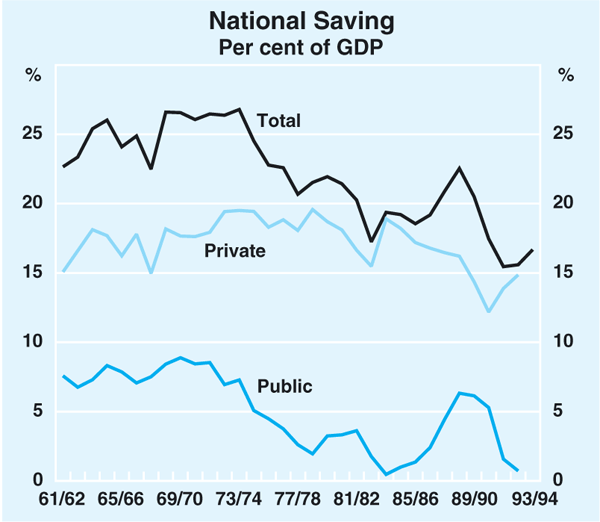
On the basis of current Government projections, the budget deficit would decline from 2.7 per cent of GDP in 1994/95 to a surplus in 1996/97 (see Graph 5). This would represent an improvement in national saving of about three percentage points in two years. I am confident that the Government will deliver an improvement of at least this order.
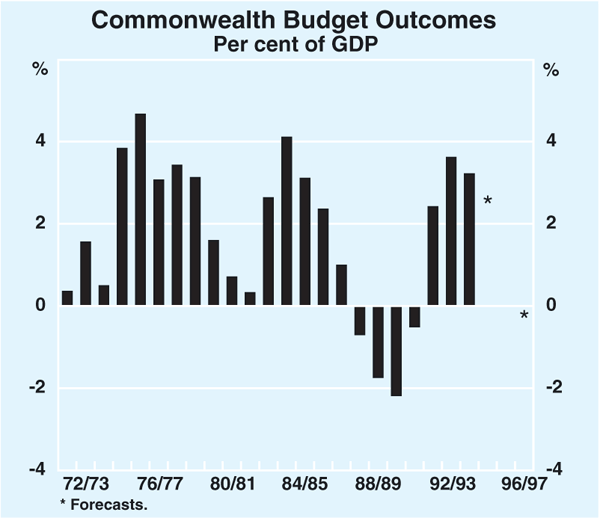
Conclusion
It is good that jobs are being created in large numbers – almost 500,000 since July 1993. The Reserve Bank is interested in job creation, not just because it is part of our charter but, more fundamentally, because that is the main route to higher living standards for ordinary Australians. But it has to be sustained job creation. This means solid growth sustained over a lengthy period, without the recovery self-destructing or having to be aborted prematurely in a surge of inflation or current account pressures.
Monetary policy was tightened in 1994 to help achieve a rate of growth consistent with low inflation and, until this objective is assured, further tightening has to remain on the agenda. The forthcoming budget also has a role to play in moderating inflationary pressures and, more importantly, in helping to lift longer-term national saving.
